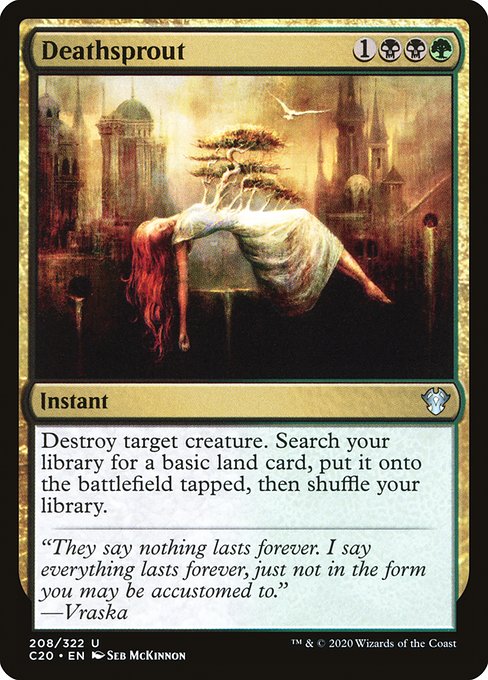
Image courtesy of Scryfall.com
Deathsprout and the casual MTG landscape
Deathsprout emerges from the Commander 2020 line as a thoughtfully designed instant that speaks directly to the casual, moodily multicolored corners of MTG. With a mana cost of {1}{B}{B}{G}, it wears its colors on its sleeve—black for removal and green for ramp—while delivering a surprisingly versatile play pattern in a single card. In kitchen-table battles and relaxed group games, where you’re juggling removal, ramp, and color fixing, Deathsprout becomes a strategic Swiss Army knife 🧙♂️🔥. It’s not a standard-legal powerhouse, yet in Historic and eternal formats, its blend of tempo and board development can tilt the balance just when you need it.
The core mechanic in play
The card’s text—“Destroy target creature. Search your library for a basic land card, put it onto the battlefield tapped, then shuffle.”—reads like a two-step plan folded neatly into one instant. Killing a threat buys you critical breathing room, and the land fetch accelerates your mana base, often fixing colors for the next turns. In casual play, where players sometimes lean on slower mana bases or heavier multicolor decks, Deathsprout’s land fetch can untap a crucial color combination just in time for a topdecked threat or a midgame curve-topper. The reasoning is simple: you’re removing a problem creature and planting a logistical advantage for the turn after, all in one card 🧠💡.
Color identity, set context, and table dynamics
Deathsprout’s two-color identity (B and G) anchors it squarely in Golgari-ish territory—degenerate removal with a touch of graveyard resilience, but in this case more about speed and consistency than recursion. Being from Commander 2020 (set code C20), it’s a reprint with modern framing, which makes it a familiar, reliable pick for casual decks that lean into land-fetch synergies and midrange boards. It’s not a flashy finisher, but in a multiplayer game with five players, a timely removal plus a ready-made land drop can reset the table’s resource balance and set up large swing turns. The flavor text, uttered by Vraska, also hints at a broader design philosophy: permanence isn’t always literal; permanence can be influence—threats removed, lands arranged, a plan put into motion that sticks around in a different form. Nothing lasts forever, as the line suggests, but Deathsprout makes tempo feel inevitable as you turn creatures into land and momentum 🧙♂️🌱.
Casual formats: why it sticks
In casual play, the pressure to answer threats while maintaining tempo can be intense. Deathsprout gives you a dual-reaction window: you respond to a creature with immediate removal, then you plant a land that often improves your next two or three turns. The ability to fetch a basic land means you don’t rely on dual lands or shock lands to fix your mana; you can shore up colors with dependable basics. For decks aiming to keep the board dynamic—think Golgari midrange, rockier attrition builds, or even graveyard-themed casuals—this card plays like a small engine: remove the problem, fix the mana, and stay on plan. In the context of EDH (Commander) and other non-rotating formats, that reliability translates into stronger long-game resilience, especially when opponents pack a suite of big threats that demand flexible, repeatable answers. The result is a card that doesn’t win the game by itself, but consistently buys you time and board presence—a hallmark of effective casual design ⚔️🎲.
Art, flavor, and collector appeal
Seb McKinnon’s art for Deathsprout carries the moody, ethereal vibe that fans love in commander staples. The artwork blends natural growth with a touch of somber mystique, complementing the flavor text about permanence and transformation. As an uncommon from a reprint-set, the card remains accessible for casual commanders who want strong utility without breaking the bank. Current market values sit modestly in the low-dollar range, which is exactly where most kitchen-table players want their toolbox—usable, stylish, and affordable. It’s a reminder that strong casual power can come in elegantly designed packages, not only in triple-rare mythic hits. Art matters, and Deathsprout delivers atmosphere to match its practical punch 🎨💎.
Design takeaways for your deckbuilding mindset
- Tempo with payoff: The removal-plus-tutor effect is a great template for casual decks that want to maintain pressure while fixing mana.
- Color-safety play: Being two colors with a white-black-green identity ensures you don’t overextend into awkward color screws—Deathsprout helps keep your mana curve clean.
- Multiplayer upside: In five-player games, denying a single threat and accelerating your board can cascade into meaningful swings before the next rounds of removal hit the stack.
Speaking of practical gear for your MTG adventures, consider keeping your tech protected on the go. The Rugged Phone Case—Impact Resistant Glossy Finish is a fitting companion for casual nights at the shop, tournament-prep sessions, or long road trips to your next game night. It’s a reminder that while Deathsprout reshapes boards, your phone needs to stay safe from the inevitable spill of d20s and dice rolls. Rugged Phone Case — Impact Resistant Glossy Finish helps keep your devices as steady as your plan to slam Deathsprout on turn four. 🧙♂️🔥
Rugged Phone Case – Impact Resistant Glossy Finish
More from our network
- https://blog.digital-vault.xyz/blog/post/far-traveler-the-philosophy-of-player-expression-in-mtg-design/
- https://blog.digital-vault.xyz/blog/post/mtg-easter-eggs-hidden-design-jokes-in-elite-skirmisher/
- https://blog.digital-vault.xyz/blog/post/howlpack-resurgence-parody-vs-serious-card-art-in-mtg/
- https://blog.digital-vault.xyz/blog/post/how-to-design-line-art-for-digital-sales-that-convert/
- https://crypto-acolytes.xyz/blog/post/the-most-iconic-arcade-sounds-that-defined-classic-gaming/